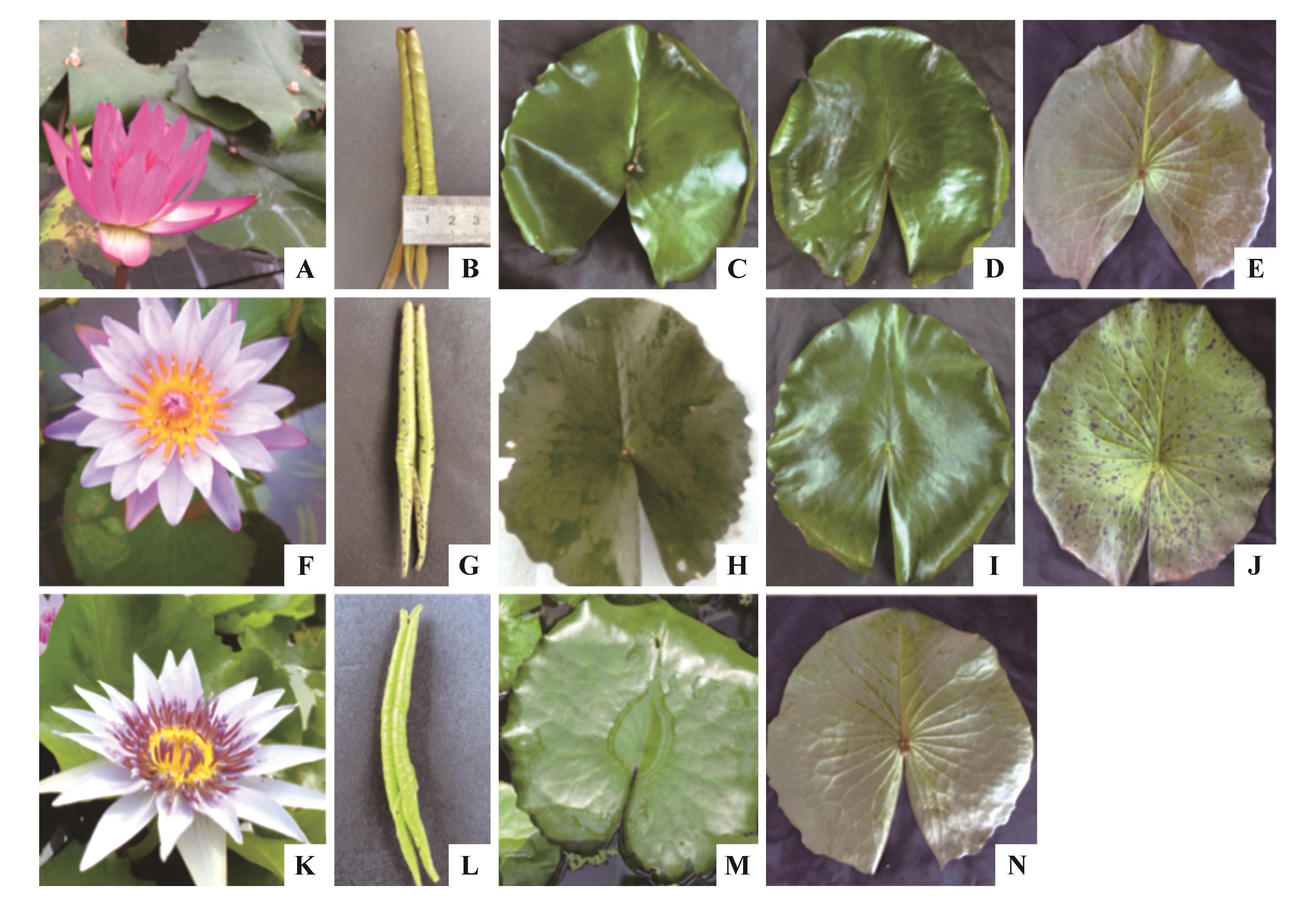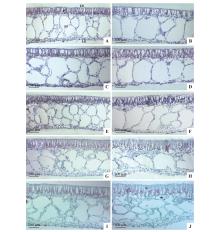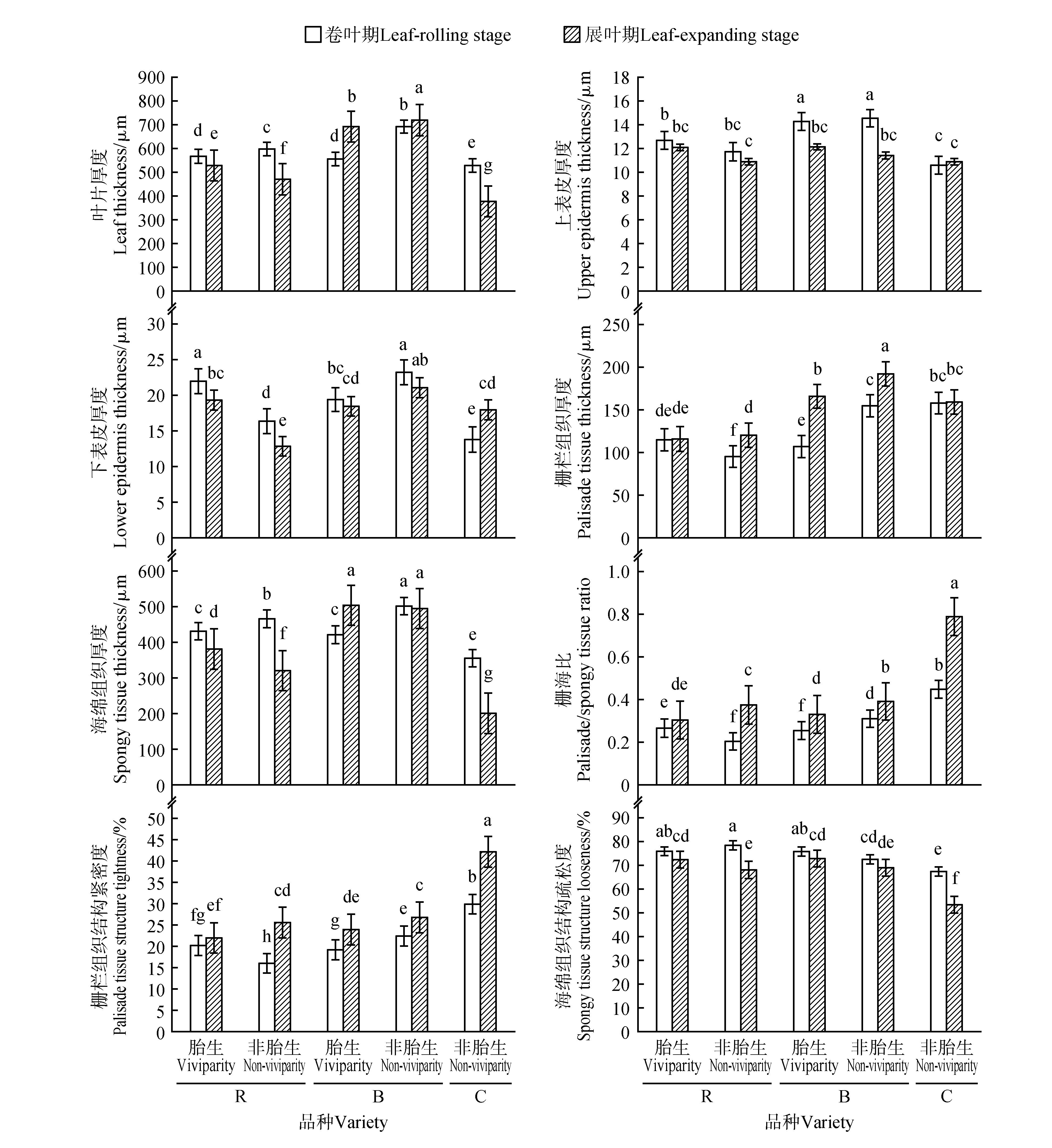Bulletin of Botanical Research ›› 2024, Vol. 44 ›› Issue (4): 528-539.doi: 10.7525/j.issn.1673-5102.2024.04.006
• Systematic and Evolutionary • Previous Articles
Yuanyuan SUN, Tianqi YANG, Xingmei AI( ), Haoran LI, Caibao ZHAO, Xuan ZHANG
), Haoran LI, Caibao ZHAO, Xuan ZHANG
Received:2023-11-14
Online:2024-07-20
Published:2024-07-09
Contact:
Xingmei AI
E-mail:xmaijl@swfu.edu.cn
CLC Number:
Yuanyuan SUN, Tianqi YANG, Xingmei AI, Haoran LI, Caibao ZHAO, Xuan ZHANG. Relationship Between the Differences in Leaves Morphology and Structure and Epiphyllous Bud Development of Tropical Water Lily before and after Leaf Expansion[J]. Bulletin of Botanical Research, 2024, 44(4): 528-539.
Add to citation manager EndNote|Ris|BibTeX
URL: https://bbr.nefu.edu.cn/EN/10.7525/j.issn.1673-5102.2024.04.006
Table 1
Leaf morphological traits and score criteria of water lilies
代号 Code | 形态性状 Morphological traits | 赋分标准 Score criteria |
|---|---|---|
| LL | 叶长 Leaf length | 随机测10片叶的叶长,取平均值 The leaf length of 10 leaves was randomly measured and the average value was taken |
| LW | 叶宽 Leaf width | 随机测10片叶的全叶宽,取平均值 The whole blade width of 10 blades was randomly measured and the average value was taken |
| LA | 叶面积 Leaf area | π×平均叶长×平均叶宽 π×average leaf length×average leaf width |
| DD | 叶裂深度 Leaf crack depth | 随机测10片叶从叶柄到叶裂口的距离,取平均值 The distance from petiole to leaf cleft of 10 leaves was randomly measured and the average value was taken |
| DP | 叶柄直径 Petiole diameter | 随机测10片叶的叶柄直径,取平均值 The petiole diameters of 10 leaves were randomly measured,and take the average value |

Fig.1
Morphological differences between viviparous and non-viviparous water lily cultivarsA.Flower of N. ‘Ruby’;B.Leaf-rolling stage of N. ‘Ruby’;C.Viviparous leaf of N. ‘Ruby’;D.Non-viviparous leaf of N.‘Ruby’;E.The back leaf of N. ‘Ruby’;F.Flower of N. ‘Blue Bird’;G.Leaf-rolling stage of N. ‘Blue Bird’;H.Viviparous leaf of N. ‘Blue Bird’;I.Non-viviparous leaf of N. ‘Blue Bird’;J.The back leaf of N. ‘Blue Bird’;K.Flower of N. ‘Colorata’;L.Leaf-rolling stage of N. ‘Colorata’;M-N.The surface and back leaf of N. ‘Colorata’.

Table 2
Morphological characteristic parameters of three water lilies
睡莲品种 Cultivars | 叶片繁殖方式 Leaf propagation mode | 叶长 Leaf length/mm | 叶宽 Leaf width/mm | 叶面积 Leaf area/cm2 | 叶裂深度 Leaf crack depth/mm | 叶柄直径 Petiole diameter/mm |
|---|---|---|---|---|---|---|
‘鲁比’ N.‘Ruby’ | 胎生 Viviparity | 211.00±7.84b | 180.60±14.74a | 299.40±27.57b | 97.60±5.72a | 6.20±0.42a |
非胎生 Non-viviparity | 216.20±24.14b | 197.80±23.82a | 339.50±79.95ab | 98.00±11.65a | 5.60±0.89a | |
‘蓝鸟’ N.‘Blue Bird’ | 胎生 Viviparity | 241.20±4.16ab | 217.20±5.01a | 411.52±14.70a | 96.00±3.23a | 6.20±0.42a |
非胎生 Non-viviparity | 244.00±10.43a | 218.60±6.57a | 419.35±29.75a | 99.40±5.32a | 6.00±0.67a | |
‘蓝星’ N.‘Colorata’ | 非胎生 Non-viviparity | 141.90±10.59c | 114.60±10.46b | 128.32±19.25c | 125.20±29.06a | 3.50±0.53b |

Fig.2
Cross-sectional structure of three water lilies during leaf rolling and expansion stagesA-B.Structure of viviparous leaves during rolling and expansion stage of N. ‘Ruby’;C-D.Structure of non-viviparous leaves during rolling and expansion stage of N. ‘Ruby’;E-F.Structure of viviparous leaves during rolling and expansion stage of N. ‘Blue bird’;G-H.Structure of non-viviparous leaves during rolling and expansion stage of N. ‘Blue bird’;I-J.Structure of N. ‘Colorata’ leaves during rolling and expansion stage;UE.Upper epidermis;LE.Lower epidermis;PT.Palisade tissue;ST.Spongy tissue.The same as below.


Fig.3
Differences in leaf tissue structure of three water lilies between leaf rolling and leaf expanding stagesR.N. ‘Ruby’;B.N. ‘Blue Bird’;C.N. ‘Colorata’.The value represented the average±standard deviation.Different letters indicated that the same index of different cultivars was significantly different at 0.05 level.

Table 3
Plasticity indexes of tissue structure at leaf rolling and expansion stages of water lilies
睡莲品种 Cultivars | 叶片繁殖方式 Leaf propagation mode | LT | UE | LE | PT | ST | P/S | TST | TSL |
|---|---|---|---|---|---|---|---|---|---|
‘鲁比’ N. ‘Ruby’ | 胎生Viviparity | 0.09 | 0.48 | 0.57 | 0.26 | 0.15 | 0.31 | 0.25 | 0.19 |
| 非胎生Non-viviparity | 0.18 | 0.56 | 0.43 | 0.21 | 0.25 | 0.29 | 0.30 | 0.31 | |
‘蓝鸟’ N. ‘Blue Bird’ | 胎生Viviparity | 0.09 | 0.35 | 0.53 | 0.23 | 0.14 | 0.26 | 0.23 | 0.15 |
| 非胎生Non-viviparity | 0.11 | 0.46 | 0.60 | 0.27 | 0.18 | 0.26 | 0.29 | 0.23 | |
‘蓝星’ N. ‘Colorata’ | 非胎生Non-viviparity | 0.15 | 0.45 | 0.57 | 0.16 | 0.25 | 0.32 | 0.19 | 0.32 |

Fig.5
Correlation coefficients between morphological and anatomical indices of viviparous(A) and non-viviparous(B) leavesDifferent colors and sizes in the above image indicated the correlation strength.*P≤0.05,**P≤0.01.Red represented positive correlation,blue represented negative correlation,and red slash represented autocorrelation.

| 1 | ZAHEDI R, DABBAGH R, GHAFOURIAN H,et al.Nickel removal by Nymphaea alba leaves and effect of leaves treatment on the sorption capacity:a kinetic and thermodynamic study[J].Water Resources,2015,42(5): 690-698. |
| 2 | 宋杰.睡莲多酚的制备、生物活性及其凝胶剂的研究[D].乌鲁木齐: 新疆大学,2022. |
| SONG J.Preparation,bioactivity and gelatinization of polyphenols from Nymphaea candida [D].Urumqi:Xinjiang University,2022. | |
| 3 | 高军侠,陶贺,党宏斌,等.睡莲、梭鱼草对铜污染水体的修复效果研究[J].地球与环境,2016,44(1):96-102. |
| GAO J X, TAO H, DANG H B,et al.Phytoremediation of copper-contaminated water by Nymphaea tetragona and Pontederia cordata [J].Earth and Environment,2016,44(1):96-102. | |
| 4 | LI C, WANG M, LUO X.Uptake of uranium from aqueous solution by Nymphaea tetragona Georgi:the effect of the accompanying heavy metals[J].Applied Radiation and Isotopes,2019,150:157-163. |
| 5 | 尉倩,李淑娟.睡莲新品种‘大唐飞霞’[J].园艺学报,2023,50(9):2067-2068. |
| WEI Q, LI S J.A New waterlily cultivar ‘Datang Feixia’[J].Acta Horticulturae Sinica,2023,50(9):2067-2068. | |
| 6 | 迟明宏,程哲,杨志娟,等.50份热带睡莲材料的耐寒性评价[J].植物资源与环境学报,2023,32(1):39-49. |
| CHI M H, CHENG Z, YANG Z J,et al.Evaluation on cold tolerance of 50 tropical water lily materials[J].Journal of Plant Resources and Environment,2023,32(1):39-49. | |
| 7 | 潘庆龙,付瑛格,谷佳,等.海南引种睡莲表型多样性分析及评价[J].热带作物学报,2021,42(10):2777-2788. |
| PAN Q L, FU Y G, GU J,et al.Analysis of phenotypic diversity of Nymphaea L.in Hainan,China[J].Chinese Journal of Tropical Crops,2021,42(10):2777-2788. | |
| 8 | 毛立彦,龙凌云,黄秋伟,等.基于SRAP分子标记的147份睡莲属植物遗传多样性分析[J].南方农业学报,2023,54(2):454-466. |
| MAO L Y, LONG L Y, HUANG Q W,et al.Genetic diversity analysis of 147 Nymphaea Linn.plants based on SRAP molecular marker[J].Journal of Southern Agriculture,2023,54(2):454-466. | |
| 9 | 吴倩,张会金,王晓晗,等.睡莲花色研究进展[J].园艺学报,2021,48(10):2087-2099. |
| WU Q, ZHANG H J, WANG X H,et al.Research progress on flower color of waterlily(Nymphaea)[J].Acta Horticulturae Sinica,2021,48(10):2087-2099. | |
| 10 | 苏群,田敏,王虹妍,等.睡莲属62个栽培种花朵挥发性成分GC-MS分析[J].热带亚热带植物学报,2022,30(4):567-574. |
| SU Q, TIAN M, WANG H Y,et al.Volatile components in flowers of 62 Nymphaea cultivars by GC-MS[J].Journal of Tropical and Subtropical Botany,2022,30(4):567-574. | |
| 11 | ZHAO Y, FAN Y Y, YU W G,et al.Ultrasound-enhanced subcritical fluid extraction of essential oil from Nymphaea alba var and its antioxidant activity[J].Journal of AOAC International,2019,102(5):1448-1454. |
| 12 | CUDALBEANU M, FURDUI B, CÂRÂC G,et al.Antifungal,antitumoral and antioxidant potential of the danube delta Nymphaea alba extracts[J].Antibiotics,2020,9(1):7-31. |
| 13 | N’GUESSAN B B, DEDE ASIAMAH A, ARTHUR N K,et al.Ethanolic extract of Nymphaea lotus L.(Nymphaeaceae) leaves exhibits in vitro antioxidant,in vivo anti-inflammatory and cytotoxic activities on Jurkat and MCF-7 cancer cell lines[J].BMC Complementary Medicine and Therapies,2021,21(1):22. |
| 14 | 潘鑫峰,叶方婷,毛志君,等.睡莲WRKY家族的全基因组鉴定和分子进化分析[J].园艺学报,2022,49(5):1121-1135. |
| PAN X F, YE F T, MAO Z J,et al.Genomic identification and molecular evolution of the WRKY family in Nymphaea colorata [J].Acta Horticulturae Sinica,2022,49(5):1121-1135. | |
| 15 | ZHANG L S, CHEN F, ZHANG X T,et al.The water lily genome and the early evolution of flowering plants[J].Nature,2020,577(7788):79-84. |
| 16 | GARCÍA-BELTRÁN J A, BARRIOS D, GONZÁLEZ-TORRES L R,et al.Vivipary in cuban cacti and an assessment of establishment success in Leptocereus scopulophilus [J].Journal of Arid Environments,2021,184:104322. |
| 17 | HUGO C S J.A compendium of vivipary in the Cactaceae:new reports,data,and research prospects[J].Brazilian Journal of Botany,2022,45(3):1001-1027. |
| 18 | BAUERT M R.Genetic diversity and ecotypic differentiation in arctic and alpine populations of Polygonum viviparum [J].Arctic and Alpine Research,2018,28(2):190-195. |
| 19 | VAZ P P, ALVES F M, DE OLIVEIRA ARRUDA R D C.Systematic implications of leaf anatomy in the Neotropical Mezilaurus clade(Lauraceae)[J].Botanical Journal of the Linnean Society,2019,189(2):186-200. |
| 20 | 田琴,段涵宁,王云强,等.中国五种仙茅科植物叶形态及其分类学意义[J].广西植物,2022,42(10):1661-1674. |
| TIAN Q, DUAN H N, WANG Y Q,et al.Leaf morphology and taxonomic significance of five species in Hypoxidaceae from China[J].Guihaia,2022,42(10):1661-1674. | |
| 21 | YUSUPOVA D M.Comparative anatomical structure of the leaf of Allium suworowii Regel (Amaryllidaceae) in different ecological conditions[J].American Journal of Plant Sciences,2018,9:2676-2683. |
| 22 | 郭文文,卓么草,方江平,等.藏东南色季拉山薄毛海绵杜鹃叶解剖结构特征与环境适应性[J].西北植物学报,2020,40(5):811-818. |
| GUO W W, ZHUO M C, FANG J P,et al.Anatomical characteristics and environmental adaptability of Rhododendron aganniphum var.schizopeplum leaf in Sejila Mountain,Southeastern Tibet[J].Acta Botanica Boreali-Occidentalia Sinica,2020,40(5):811-818. | |
| 23 | 李林鑫,陶长铸,林景泉,等.不同杉木无性系叶片解剖结构对大气增温的响应[J].生态学报,2022,42(20):8385-8397. |
| LI L X, TAO C Z, LIN J Q,et al.Response of needle anatomical structure of different Chinese fir clones to atmospheric warming[J].Acta Ecologica Sinica,2022,42(20):8385-8397. | |
| 24 | 谢欢,艾星梅,李宇航,等.睡莲叶脐着生胎芽与叶片不同部位碳水化合物代谢的关系[J].应用生态学报,2022,33(9):2431-2440. |
| XIE H, AI X M, LI Y H,et al.Relationship between epiphyllous bud of tropical waterlily(Brachyceras) umbilics and carbohydrate metabolism in different parts of leaves[J].Chinese Journal of Applied Ecology,2022,33(9):2431-2440. | |
| 25 | 孙旺旺,孟宪敏,徐秀源,等.金叶连翘叶片色素含量和解剖结构研究[J].植物研究,2020,40(3):321-329. |
| SUN W W, MENG X M, XU X Y,et al.Contents of pigments and anatomical structure in the leaves of Forsythia koreana ‘Sun Gold’[J].Bulletin of Botanical Research,2020,40(3):321-329. | |
| 26 | HE N P, LIU C C, TIAN M,et al.Variation in leaf anatomical traits from tropical to cold-temperate forests and linkage to ecosystem functions[J].Functional Ecology,2018,32(1):10-19. |
| 27 | 张敏,王贺新,徐国辉,等.朝鲜越桔的解剖结构及其环境适应性[J].生态学杂志,2018,37(9):2581-2588. |
| ZHANG M, WANG H X, XU G H,et al.Anatomical structure and environmental adaptability of Vaccinium hirtum Thunb.var.koreanum(Nakai) Kitamura[J].Chinese Journal of Ecology,2018,37(9):2581-2588. | |
| 28 | 许少祺,刘浩地,李雪,等.两种野豌豆属植物叶片形态结构及其生态适应性研究[J].东北农业大学学报,2021,52(3):26-33. |
| XU S Q, LIU H D, LI X,et al.Study on leaf morphological structures of two species in Vicia and relation with ecological adaptability[J].Journal of Northeast Agricultural University,2021,52(3):26-33. | |
| 29 | 朱琨,郑桂华,刘丽杰,等.草地早熟禾叶片表皮解剖结构与抗白粉病性的研究[J].草地学报,2021,29(7):1430-1435. |
| ZHU K, ZHENG G H, LIU L J,et al.Study on anatomical structure of leaf epidermis and powdery mildew resistance in Poa pratensis [J].Acta Agrestia sinica,2021,29(7):1430-1435. | |
| 30 | 卫沙沙,李鹏鹏,袁龙义,等.叶异形水生植物不同发育阶段叶片的结构和无机碳获取策略[J].植物科学学报,2022,40(4):544-552. |
| WEI S S, LI P P, YUAN L Y,et al.Leaf structure and inorganic carbon acquisition strategies of heteroblastic aquatic plants at different stages of development[J].Plant Science Journal,2022,40(4):544-552. | |
| 31 | 王坤,韦晓娟,李宝财,等.金花茶组植物叶解剖结构特征与抗旱性的关系[J].中南林业科技大学学报,2019,39(12):34-39. |
| WANG K, WEI X J, LI B C,et al.Relationship between leaf anatomical structure and drought resistance of Camellia sect.Chrysantha [J].Journal of Central South University of Forestry & Technology,2019,39(12):34-39. | |
| 32 | 赵杏花,张格,韩彦隆,等.唐古特白刺枝叶形态结构对水分条件的响应[J].生态学杂志,2023,42(6):1290-1298. |
| ZHAO X H, ZHANG G, HAN Y L,et al.Responses of branch and leaf morphology and structure of Nitraria tangutorum to water conditions[J].Chinese Journal of Ecology,2023,42(6):1290-1298. | |
| 33 | 顾肖璇.不同叶结构红树植物固碳能力比较:从叶片到植株[D].厦门:厦门大学,2020. |
| GU X X.Comparison of carbon sequestrated capacity of mangrove species with different leaf structure:from leaf to stand level study[D].Xiamen:Xiamen University,2020. | |
| 34 | CATIAN G, SCREMIN-DIAS E.Compared leaf anatomy of Nymphaea(Nymphaeaceae) species from Brazilian flood plain[J].Brazilian Journal of Biology,2013,73(4):809-817. |
| 35 | 张小燕, SHAN ALISON W K, TADASHI K,等.种源地对两种红树叶片结构和功能的影响:对温度的适应性遗传[J].植物生态学报,2021,45(11):1241-1250. |
| ZHANG X Y, SHAN ALISON W K, TADASHI K,et al.Effects of provenance on leaf structure and function of two mangrove species:the genetic adaptation to temperature[J].Chinese Journal of Plant Ecology,2021,45(11):1241-1250. | |
| 36 | 梁玲,黄玉琼,陈小红.不同色彩珙桐叶片和苞片解剖结构及色素含量比较研究[J].西北植物学报,2020,40(9):1539-1548. |
| LIANG L, HUANG Y Q, CHEN X H,et al.Anatomical structure and pigment content of Davidia involucrata leaves and bracts with different colors[J].Acta Botanica Boreali-Occidentalia Sinica,2020,40(9):1539-1548. | |
| 37 | 陈燕,刘锴栋,黎海利,等.5种红树植物的叶片结构及其抗逆性比较[J].东北林业大学学报,2014,42(7):27-31. |
| CHEN Y, LIU K D, LI H L,et al.Leaf stuctures and stress resistance in five mangrove species[J].Journal of Northeast Forestry University,2014,42(7):27-31. | |
| 38 | 杨宽.6种睡莲叶片解剖结构及耐寒性评价[J].分子植物育种,2021,19(20):6910-6917. |
| YANG K.Leaf anatomic structure and cold tolerance evaluation of 6 Nymphaea varieties[J].Molecular Plant Breeding,2021,19(20):6910-6917. | |
| 39 | 王玉萍,高会会,张峰,等.珠芽蓼叶片对海拔变化的表型可塑性[J].应用生态学报,2021,32(6):2070-2078. |
| WANG Y P, GAO H H, ZHANG F,et al.Altitudinal phenotypic plasticity of leaf characteristics of Polygonum viviparum [J].Chinese Journal of Applied Ecology,2021,32(6):2070-2078. | |
| 40 | 纪若璇,于笑,常远,等.蒙古莸叶片解剖结构的地理种源变异及其对环境变化响应的意义[J].植物生态学报,2020,44(3):277-286. |
| JI R X, YU X, CHANG Y,et al.Geographical provenance variation of leaf anatomical structure of Caryopteris mongholica and its significance in response to environmental changes[J].Chinese Journal of Plant Ecology,2020,44(3):277-286. | |
| 41 | VАSYL B, ОLEKSANDR V P, ОLENA P B,et al.Photosynthetic apparatus features of Nuphar lutea and Nymphaea alba floating leaves can affect their redistribution[J].Flora,2022,292:152080. |
| [1] | ZHAO Zhong-Xin;WANG Jian*;LI Qin;SHANG Xiao. Cloning a Homologous Linalool Synthase Gene of Lavandula latifolia and Construction of Plant Expression Vector [J]. Bulletin of Botanical Research, 2013, 33(3): 308-316. |
| Viewed | ||||||
|
Full text |
|
|||||
|
Abstract |
|
|||||